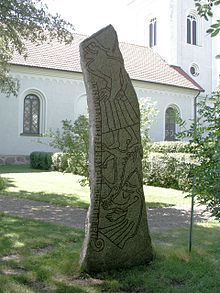Ledberg stone
[1] This is thought to be a depiction of Odin being devoured by the wolf Fenrir at Ragnarök, the final battle in Norse mythology, in which several gods meet their death.
[2] Some scholars, however, believe that the images of the Ledberg stone depict the final story of either Þorgautr or Gunna,[citation needed] who are memorialized in the runic inscription.
Wolves were often used in Viking art and poetry to signify combat,[3] so it is thought to be unlikely that the figure fell in battle due to wounds caused by a wolf.
It reads:[5] ᛒᛁᛋᛁ(b)isi᛬·ᛋᛅᛏᛁsati᛬:ᛋᛏᛁsti[n]᛬:ᚦᛁᛋᛁþisi᛬:ᛁᚠᛏᛁᛦiftiʀ᛬:ᚦᚢᚱᚴᚢᛏþurkut᛬:ᚢ----ᚦᛁu----þi᛬:ᚠᛅᚦᚢᚱfaþurᛒᛁᛋᛁ ᛬ ᛋᛅᛏᛁ ᛬ ᛋᛏᛁ ᛬ ᚦᛁᛋᛁ ᛬ ᛁᚠᛏᛁᛦ ᛬ ᚦᚢᚱᚴᚢᛏ ᛬ ᚢ----ᚦᛁ ᛬ ᚠᛅᚦᚢᚱ(b)isi · sati : sti[n] : þisi : iftiʀ : þurkut : u----þi : faþurBisi placed this stone in memory of Þorgautr … his father.᛬:ᛋᛁᚾsin᛬:ᚢᚴuk᛬:ᚦᚢþu᛬:ᚴᚢᚾᛅkuna᛬:ᛒᛅᚦᛁbaþi᛬:᛬ ᛋᛁᚾ ᛬ ᚢᚴ ᛬ ᚦᚢ ᛬ ᚴᚢᚾᛅ ᛬ ᛒᛅᚦᛁ ᛬: sin : uk : þu : kuna : baþi :And Gunna, both.The final part of the B-side contains a rhyming charm or spell (galdr), which reads: ᚦᛘᚴþmk᛬:ᛁᛁᛁiii᛬:ᛋᛋᛋsss᛬:ᛏᛏᛏttt᛬:ᛁᛁᛁiii᛬:ᛚᛚᛚlll᛬:ᚦᛘᚴ ᛬ ᛁᛁᛁ ᛬ ᛋᛋᛋ ᛬ ᛏᛏᛏ ᛬ ᛁᛁᛁ ᛬ ᛚᛚᛚ ᛬þmk : iii : sss : ttt : iii : lll :which is to be read (in normalized Old Icelandic spelling): þistill,thistle,mistill,mistletoe,kistillcasket [6]þistill, mistill, kistillthistle, mistletoe, casketThis type of charm (istill formula) is found on a few other inscriptions, among them the runic inscription on the Gørlev runestone, DR 239, from Sjælland, Denmark.
[6] It has been noted that Pliny the Elder recorded that the Celts gathered mistletoe as a cure for infertility, and that singing a charm over herbs increased their power, which may have led to the þistill mistill kistill combination.

